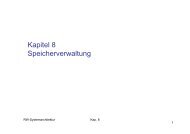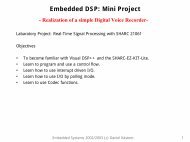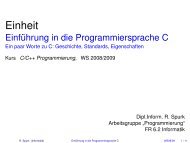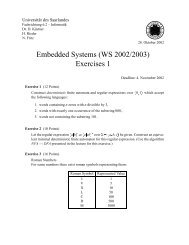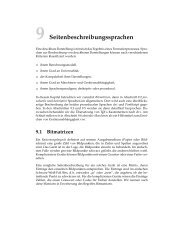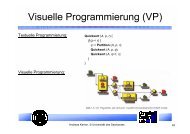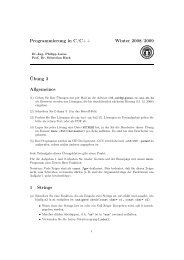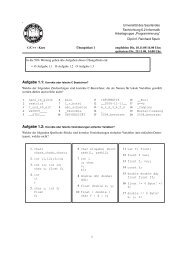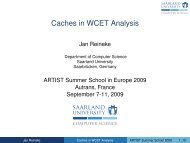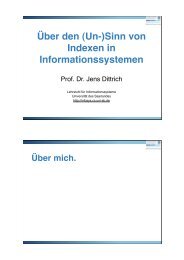Lecture 10 (pdf)
Lecture 10 (pdf)
Lecture 10 (pdf)
You also want an ePaper? Increase the reach of your titles
YUMPU automatically turns print PDFs into web optimized ePapers that Google loves.
The Constructive Semantics<br />
• Logical correctness is not in accordance with the intention of the<br />
language, ie with its intuitive semantics and with the intended<br />
sequential character of test statements.<br />
• Example:<br />
module P<strong>10</strong>:<br />
present O then nothing end; emit O<br />
is logically correct, but the information that O is present flows<br />
backwards across the sequencing operator ; contradicting the<br />
basic intuition about sequential execution.<br />
• Aside from the explicit concurrency || all Esterel statements are<br />
sequential.<br />
Embedded Systems 2002/2003 (c) Daniel Kästner. 1
The Constructive Semantics<br />
• Idea: do not check assumptions about signal statuses, but<br />
propagate facts about control flow and signal statuses. Selfjustification<br />
is replaced by fact-to-fact propagation.<br />
• Accounts for programmer's natural way of thinking: in terms of<br />
cause and effect.<br />
• Three-valued logic for signals: present, absent, unknown.<br />
• In each instant the statuses of the input signals are given by the<br />
environment and the statuses of the other signals are initially<br />
set to unknown.<br />
Embedded Systems 2002/2003 (c) Daniel Kästner. 2
The Constructive Semantics<br />
• Three equivalent presentations:<br />
– Constructive behavioral semantics<br />
• Derived from the logical behavioral semantics<br />
• Constructive restrictions are added to the logical coherence rule<br />
– Constructive operational semantics<br />
• Based on term rewriting rules defining microstep sequences<br />
• Simplest way of defining an efficient interpreter<br />
– Circuit semantics<br />
• Translation of program into constructive circuits<br />
• Core of the Esterel v5 compiler.<br />
Embedded Systems 2002/2003 (c) Daniel Kästner. 3
Constructive Behavioral Semantics<br />
• Logical coherence semantics augmented by reasoning about<br />
what a program must or cannot do, both predicates being<br />
disjoint and defined in a constructive way.<br />
• The must predicate determines which signals are present and<br />
which statements are executed.<br />
• The cannot predicate determines when signals are absent and<br />
it serves in pruning out false execution paths.<br />
• A program is accepted as constructive if and only if fact<br />
propagation using the must and cannot predicates suffices in<br />
establishing presence or absence of all signals.<br />
Embedded Systems 2002/2003 (c) Daniel Kästner. 4
Constructive Behavioral Semantics<br />
• Logical Coherence Law:<br />
– A signal S is present in an instant iff an emit S statement is<br />
executed in this instant.<br />
• Constructive Coherence Law:<br />
– A signal S is present iff an emit S statement must be executed.<br />
– A signal S is absent iff an emit S statement cannot be executed.<br />
Embedded Systems 2002/2003 (c) Daniel Kästner. 5
Constructive Behavioral Semantics<br />
• A signal can have three statuses:<br />
– +: known to be present<br />
– –: known to be absent<br />
– ⊥: yet unknown<br />
• must and cannot predicates are defined by structural induction on<br />
statements.<br />
• p ; q<br />
– Must (resp. can) execute q if p must (resp. can) terminate<br />
• present S then p else q end<br />
– S known to be present -> Test behaves as p<br />
– S known to be absent -> Test behaves as q<br />
– S yet unknown -> Test can do whatever p or q can do; there is nothing<br />
the test must do.<br />
Embedded Systems 2002/2003 (c) Daniel Kästner. 6
module P1:<br />
input I;<br />
output O;<br />
signal S1, S2 in<br />
present I then emit S1 end (i1)<br />
||<br />
present S1 else emit S2 end (i2)<br />
||<br />
present S2 then emit O end (i3)<br />
end signal<br />
end module<br />
Example 1<br />
• If I is present:<br />
– i1 must take its then branch, emit S1<br />
and terminate → S1 present<br />
– i2 must take its (empty) then branch<br />
and cannot take its else branch →<br />
emit S2 cannot be executed, S2<br />
cannot be emitted → S2 absent<br />
– i3 cannot take its then branch → O<br />
cannot be emitted and is absent.<br />
• If I is absent:<br />
– i1 cannot take its then branch → emit<br />
S1 cannot be executed → S1 absent<br />
– i2 must take its then branch → emit<br />
S2 must be executed → S2 present.<br />
– i3 must take its then branch → emit O<br />
must be executed → O present.<br />
Embedded Systems 2002/2003 (c) Daniel Kästner. 7
module P2:<br />
output O;<br />
signal S in<br />
emit S;<br />
present O then<br />
present S then<br />
pause<br />
end;<br />
emit O<br />
end<br />
end signal<br />
Example 2 – Part 1<br />
• Analyze what signal S must do with status ⊥ for O.<br />
– Analyze body with status ⊥ for O and S.<br />
– S must be emitted.<br />
– Thus: redo the analysis with status ⊥ for O and + for S.<br />
– Status of O is unknown: there is nothing that the present<br />
statement must do. Progress can only be made by<br />
analyzing what we cannot do in the branches of the test.<br />
– The then branch contains a present S test. Since S is<br />
known to be present, we cannot take the implicit else<br />
branch. Since the then branch is a pause statement it<br />
cannot terminate. Therefore the emit O statement cannot<br />
be executed and O cannot be emitted.<br />
– As a consequence O must be set absent and the analysis<br />
must be redone with status – for O.<br />
Embedded Systems 2002/2003 (c) Daniel Kästner. 8
module P2:<br />
output O;<br />
signal S in<br />
emit S;<br />
present O then<br />
present S then<br />
pause<br />
end;<br />
emit O<br />
end<br />
end signal<br />
Example 2 – Part 2<br />
• Analyze what signal S must do with status – for O.<br />
– The implicit else branch of the present O test that<br />
terminates execution must be taken.<br />
– The program is constructive since we have fully<br />
determined the signal statuses.<br />
Embedded Systems 2002/2003 (c) Daniel Kästner. 9
Constructive Behavioral Semantics<br />
• signal S in p end<br />
– Can: recursively analyze p with status ⊥ for S<br />
– Must:<br />
• Assume we already know that we must execute the declaration in<br />
some signal context E<br />
• Must compute final status of S to determine signal context of p<br />
• First analyze p in E augmented by setting the unknown status ⊥ for S<br />
• If S must be emitted:<br />
– propagate this information by reanalyzing p in E with S present<br />
– This may generate more information about the other signals<br />
• If S cannot be emitted:<br />
– reanalyze p in E with S absent<br />
Embedded Systems 2002/2003 (c) Daniel Kästner. <strong>10</strong>
Constructive Behavioral Semantics –<br />
Formal Definition<br />
• Let S be a set of signals.<br />
An event E is a mapping E : S → B ⊥ = {+, –, ⊥} which assigns a<br />
status from B ⊥ to all signals in S.<br />
• Notation:<br />
– s + : E (s) = +<br />
– s - : E (s) = –<br />
– E ⊆ E ': s + in E ⇒ s + in E '<br />
• Singleton event {s + }:<br />
{s + }(s ) = + and {s + }(s ')= – forall s ' ≠ s<br />
• Let an event E for a set S be given, a signal s possibly not in S and a<br />
status b in B ⊥ . Then E * s b is an event for the set S ∪{s } where<br />
E*s b (s ) = b and E*s b (s ') = E (s ') ∀ s ' ≠ s.<br />
Embedded Systems 2002/2003 (c) Daniel Kästner. 11
Constructive Behavioral Semantics –<br />
Formal Definition<br />
• The statements nothing, pause and exit are represented<br />
by completion codes k >= 0:<br />
– nothing is encoded by 0<br />
– pause is encoded by 1<br />
– exit T is encoded by 2, if the directly enclosing trap declaration is<br />
that of T and n +2 if n trap declarations have to be traversed<br />
before reaching that of T.<br />
• To handle trap propagation we define two operators<br />
↓ k<br />
↑<br />
k<br />
=<br />
⎧0,<br />
⎪<br />
⎨1,<br />
⎪<br />
⎩ k<br />
−1,<br />
⎧ k,<br />
= ⎨<br />
⎩k<br />
+ 1,<br />
if k = 0 or k<br />
if k = 1<br />
if k > 2<br />
if<br />
if<br />
k = 0 or k<br />
k > 1<br />
=<br />
=<br />
Embedded Systems 2002/2003 (c) Daniel Kästner. 12<br />
2<br />
2
Constructive Behavioral Semantics –<br />
Formal Definition<br />
• Given a program P with body p and an input event I. A reaction of<br />
the program is given by a behavioral transition of the form<br />
P P'<br />
O ⎯⎯→ I<br />
where O is an output event and the resulting program P ' is the new<br />
state reached by P after the reaction. P ' is called the derivative of P<br />
by the reaction.<br />
• The statement transition relation has the form<br />
p<br />
E', k<br />
⎯⎯→ E<br />
where<br />
p'<br />
– E is an event that defines the status of all signals in the scope of p<br />
– E ' is an event composed of all signals emitted by p in the reaction, k is<br />
the completion code returned.<br />
The statement p ' is called the derivative of p by the reaction.<br />
Embedded Systems 2002/2003 (c) Daniel Kästner. 13
Constructive Behavioral Semantics –<br />
Formal Definition<br />
O<br />
O,<br />
k<br />
P ⎯⎯→ P'<br />
⇔ p ⎯⎯→<br />
p'<br />
I I ∪ O<br />
⎧∅<br />
Max(<br />
K,<br />
L)<br />
= ⎨<br />
⎩ {max{ k,<br />
l}},<br />
for<br />
some<br />
Embedded Systems 2002/2003 (c) Daniel Kästner. 14<br />
k<br />
if K = ∅ or L = ∅<br />
for k ∈ K,<br />
l ∈ L
Constructive Behavioral Semantics –<br />
Formal Definition<br />
• The Must function determines what must be done in a reaction<br />
.<br />
where<br />
P P'<br />
O ⎯⎯→ I<br />
Must(p, E ) = 〈S, K 〉<br />
– E is an event,<br />
– S is the set of signals that p must emit<br />
– K is the set of completion codes that p must return.<br />
• We write<br />
Must(p, E ) = 〈S, K 〉 =: 〈Must s (p,E ), Must k (p,E )〉.<br />
Embedded Systems 2002/2003 (c) Daniel Kästner. 15
Constructive Behavioral Semantics –<br />
Formal Definition<br />
• The function Cannot m (p,E ) is used to prune out false paths.<br />
Cannot m (p,E ) = 〈Cannot s m (p,E ), Cannotk m (p,E )〉 = 〈S,K 〉<br />
– S is the set of signals that p cannot emit<br />
– K is the set of completion codes that p cannot exit with when the input<br />
event is E.<br />
• m ∈ {+, ⊥} indicates whether it is known that the statement p must<br />
be executed in the event E. The case m = – will never occur since<br />
Cannot will only be called for potentially executable statements.<br />
• In the following, we will use Can m (p,E ) since it is easier to be defined<br />
formally; from this, Cannot m (p,E ) can be determined by<br />
componentwise complementation.<br />
Embedded Systems 2002/2003 (c) Daniel Kästner. 16
Constructive Behavioral Semantics –<br />
Formal Definition<br />
• Must and Can m are defined by structural induction over the kernel<br />
statements.<br />
Must(<br />
k,<br />
E)<br />
= Canm(<br />
k,<br />
E)<br />
= ∅,<br />
{ k}<br />
Must(<br />
emit S,<br />
E)<br />
= Canm(<br />
emit S,<br />
E)<br />
= { s}<br />
, { 0}<br />
⎧Must(<br />
p,<br />
E),<br />
if s+<br />
∈E<br />
⎪<br />
Must(<br />
present s then p else q end,<br />
E)<br />
= Must(<br />
q,<br />
E),<br />
if s−<br />
⎨<br />
∈E<br />
⎪<br />
∅,<br />
∅ , if s⊥<br />
∈E<br />
Canm(<br />
present s then p else q end,<br />
E)<br />
=<br />
Must(<br />
suspend p when s,<br />
E)<br />
= Must(<br />
p,<br />
E)<br />
Canm(<br />
suspend p when s,<br />
E)<br />
= Canm(<br />
p,<br />
E)<br />
⎪<br />
⎩<br />
⎧<br />
⎪<br />
⎨<br />
⎪<br />
⎪<br />
⎩<br />
Canm(<br />
p,<br />
E),<br />
Canm(<br />
q,<br />
E),<br />
Can⊥(<br />
p,<br />
E)<br />
∪Can⊥(<br />
q,<br />
E),<br />
s+<br />
∈E<br />
s−<br />
∈E<br />
s⊥<br />
∈E<br />
Embedded Systems 2002/2003 (c) Daniel Kästner. 17<br />
if<br />
if<br />
if
Constructive Behavioral Semantics –<br />
Must(<br />
p;<br />
q,<br />
E)<br />
=<br />
⎧<br />
⎪<br />
⎨<br />
⎪<br />
⎩<br />
Formal Definition<br />
Must(<br />
p,<br />
E),<br />
Must ( p,<br />
E)<br />
∪ Must ( q,<br />
E),<br />
Must ( q,<br />
E)<br />
s<br />
s k<br />
We analyze q only if p must terminate in which<br />
case the completion code 0 of p is discarded.<br />
Embedded Systems 2002/2003 (c) Daniel Kästner. 18<br />
,<br />
if<br />
if<br />
Must ( p,<br />
E)<br />
≠{<br />
0}<br />
k<br />
Must ( p,<br />
E)<br />
= { 0}<br />
k
Embedded Systems 2002/2003 (c) Daniel Kästner. 19<br />
Constructive Behavioral Semantics –<br />
Formal Definition<br />
otherwise.<br />
argument<br />
with<br />
terminate,<br />
must<br />
if<br />
and<br />
if<br />
argument<br />
with<br />
q<br />
analyze<br />
We<br />
=⊥<br />
+<br />
=<br />
+<br />
=<br />
=⊥<br />
∈<br />
∈<br />
+<br />
=<br />
+<br />
=<br />
∈<br />
∪<br />
∪<br />
∉<br />
=<br />
⎪<br />
⎪<br />
⎪<br />
⎪<br />
⎪<br />
⎪<br />
⎪<br />
⎩<br />
⎪<br />
⎪<br />
⎪<br />
⎪<br />
⎪<br />
⎪<br />
⎨<br />
⎧<br />
m'<br />
p<br />
m<br />
m'<br />
m<br />
with<br />
E<br />
p<br />
m<br />
k<br />
Can<br />
if<br />
E<br />
p<br />
k<br />
Must<br />
and<br />
m<br />
if<br />
m<br />
with<br />
E<br />
p<br />
m<br />
k<br />
Can<br />
if<br />
E<br />
q<br />
m<br />
k<br />
Can<br />
m<br />
k<br />
Can<br />
E<br />
q<br />
m<br />
s<br />
Can<br />
E<br />
p<br />
m<br />
s<br />
Can<br />
E<br />
p<br />
m<br />
k<br />
Can<br />
if<br />
E<br />
p<br />
m<br />
Can<br />
E<br />
q<br />
p<br />
m<br />
Can<br />
otherwise<br />
'<br />
)<br />
,<br />
(<br />
0<br />
or<br />
)<br />
,<br />
(<br />
0<br />
'<br />
)<br />
,<br />
(<br />
0<br />
)<br />
,<br />
(<br />
'<br />
{0}<br />
\<br />
E)<br />
(p,<br />
),<br />
,<br />
(<br />
'<br />
)<br />
,<br />
(<br />
)<br />
,<br />
(<br />
0<br />
),<br />
,<br />
(<br />
)<br />
,<br />
;<br />
(
Constructive Behavioral Semantics –<br />
Must(<br />
loop p end,<br />
E)<br />
= Must(<br />
p,<br />
E)<br />
Canm(<br />
loop p end,<br />
E)<br />
= Canm(<br />
p,<br />
E)<br />
Formal Definition<br />
Must(<br />
p || q,<br />
E)<br />
= Must<br />
s<br />
( p,<br />
E)<br />
∪ Must<br />
s<br />
( q,<br />
E)<br />
, Max(<br />
Must ( p,<br />
E),<br />
Must ( q,<br />
E)<br />
k k<br />
Canm(<br />
p || q,<br />
E)<br />
= Can<br />
m<br />
( p,<br />
E)<br />
Can<br />
m<br />
( q,<br />
E)<br />
, Max(<br />
Can<br />
m<br />
( p,<br />
E),<br />
Can<br />
m<br />
s<br />
∪<br />
s<br />
( q,<br />
E)<br />
k k<br />
• The Max operation e.g. ensures that || cannot<br />
terminate if one of its branches cannot do so.<br />
Embedded Systems 2002/2003 (c) Daniel Kästner. 20
Embedded Systems 2002/2003 (c) Daniel Kästner. 21<br />
Constructive Behavioral Semantics –<br />
Formal Definition<br />
)<br />
,<br />
(<br />
),<br />
,<br />
(<br />
)<br />
,<br />
(<br />
)<br />
,<br />
(<br />
),<br />
,<br />
(<br />
)<br />
},<br />
({<br />
})<br />
({<br />
)<br />
,<br />
(<br />
)<br />
,<br />
(<br />
),<br />
,<br />
(<br />
)<br />
,<br />
(<br />
)<br />
,<br />
(<br />
),<br />
,<br />
(<br />
)<br />
},<br />
({<br />
})<br />
({<br />
)<br />
,<br />
(<br />
E<br />
q<br />
m<br />
k<br />
Can<br />
E<br />
q<br />
m<br />
s<br />
Can<br />
E<br />
q<br />
m<br />
Can<br />
E<br />
q<br />
m<br />
k<br />
Can<br />
E<br />
q<br />
m<br />
s<br />
Can<br />
E<br />
q<br />
m<br />
Can<br />
p<br />
m<br />
Can<br />
E<br />
end<br />
p<br />
in<br />
T<br />
trap<br />
m<br />
Can<br />
E<br />
q<br />
k<br />
Must<br />
E<br />
q<br />
s<br />
Must<br />
E<br />
q<br />
Must<br />
E<br />
q<br />
k<br />
Must<br />
E<br />
q<br />
s<br />
Must<br />
E<br />
q<br />
Must<br />
p<br />
Must<br />
E<br />
end<br />
p<br />
in<br />
T<br />
trap<br />
Must<br />
↑<br />
=<br />
↑<br />
↓<br />
=<br />
↑<br />
=<br />
↑<br />
=<br />
↑<br />
↓<br />
=<br />
↑<br />
=
Constructive Behavioral Semantics –<br />
Must(<br />
signal s in<br />
Canm(<br />
signal s in<br />
p,<br />
E)<br />
=<br />
p,<br />
E)<br />
=<br />
⎧<br />
⎪<br />
⎪<br />
⎨<br />
⎪<br />
⎪<br />
⎪⎩<br />
⎧<br />
⎪<br />
⎪<br />
⎨<br />
⎪<br />
⎪<br />
⎪⎩<br />
Formal Definition<br />
Must(<br />
p,<br />
E ∗s<br />
+<br />
) \ { s},<br />
Must(<br />
p,<br />
E ∗s<br />
−<br />
) \ { s},<br />
Must(<br />
p,<br />
E ∗s<br />
⊥<br />
) \ { s},<br />
Can<br />
+<br />
( p,<br />
E ∗s<br />
+<br />
) \ { s},<br />
Can<br />
m<br />
( p,<br />
E ∗s<br />
−<br />
) \ { s},<br />
Can<br />
m<br />
( p,<br />
E ∗s<br />
⊥<br />
s<br />
) \ { s},<br />
if s∈<br />
Must ∗<br />
⊥<br />
s<br />
( p,<br />
E s )<br />
if s∉Can<br />
+<br />
( p,<br />
E ∗s<br />
⊥<br />
s<br />
)<br />
otherwise<br />
if m = + and s∈<br />
Must ∗<br />
⊥<br />
s<br />
( p,<br />
E s )<br />
if s∉Can<br />
+<br />
( p,<br />
E ∗s<br />
⊥<br />
s<br />
)<br />
otherwise<br />
• We first analyze the body p with status ⊥ for s with the same m argument.<br />
• If m=+ and we find that the signal must be emitted we reanalyze p with status + for s.<br />
• For both m=+ and m= ⊥ if the signal cannot be emitted we reanalyze p with status – and with<br />
the same m.<br />
• Otherwise we return the result of the analysis of p with status ⊥ for s.<br />
• Note that the signal status can be set to + only if m=+. This is necessary to avoid speculative<br />
computations.<br />
Embedded Systems 2002/2003 (c) Daniel Kästner. 22
Constructive Behavioral Semantics<br />
• The constructiveness analysis involves many recomputations:<br />
Once a signal status has been set, the body of its declaration<br />
(the whole program for an output) has to be reanalyzed, this<br />
way re-establishing many facts that are already known.<br />
• The goal of the operational and circuit semantics is to avoid<br />
recomputing known facts.<br />
Embedded Systems 2002/2003 (c) Daniel Kästner. 23
module P4:<br />
input I;<br />
output O;<br />
signal S1, S2 in<br />
present I then emit S1 end<br />
||<br />
present S1 then emit S2 end<br />
||<br />
present S2 then emit O end<br />
end module<br />
module P3:<br />
input I;<br />
output O1,O2;<br />
present I then<br />
present O2 then emit O1 end<br />
else<br />
present O1 then emit O2 end<br />
end present<br />
end module<br />
Example<br />
accepted by constructiveness<br />
rejected by acyclicity test<br />
reactive and deterministic<br />
accepted by constructiveness<br />
Embedded Systems 2002/2003 (c) Daniel Kästner. 24
module P1:<br />
output O;<br />
present O<br />
else emit O<br />
end present<br />
end module<br />
module P2:<br />
output O;<br />
present O<br />
then emit O<br />
end present<br />
end module<br />
Examples<br />
rejected by constructiveness<br />
rejected by constructiveness<br />
Embedded Systems 2002/2003 (c) Daniel Kästner. 25
module Px:<br />
output O;<br />
present O then emit O else emit O<br />
end module<br />
Examples<br />
logically correct by self<br />
justification<br />
rejected by constructiveness<br />
Embedded Systems 2002/2003 (c) Daniel Kästner. 26
Advanced Constructiveness<br />
• Preemption statements behave as tests for the guard<br />
in each instant where the guard is active. Their<br />
constructiveness test is straightforward.<br />
module Py:<br />
output O;<br />
abort<br />
sustain O<br />
when O<br />
non-constructive in the first instant<br />
non-constructive (non reactive) in later instants<br />
Embedded Systems 2002/2003 (c) Daniel Kästner. 27
Advanced Constructiveness<br />
• Preemption statements (abort) behave as tests for the guard in<br />
each instant where the guard is active. Their constructiveness<br />
test is straightforward.<br />
• Signal expressions:<br />
– not e: straightforward<br />
– e1 or e2: evaluates to true as soon as one of e1 or e2 evaluates to<br />
true, even if the other one is still unknown.<br />
– e1 and e2: analogous<br />
• The computation of values of valued signals cannot be lazy<br />
since the value is known only when all emitters are either<br />
executed or discarded (due to signal combination).<br />
A statement such as emit S(2) is handled as<br />
emit S; ?S:=2; by the constructiveness test.<br />
Embedded Systems 2002/2003 (c) Daniel Kästner. 28
Advanced Constructiveness<br />
• Signal expressions:<br />
– not e: straightforward<br />
– e1 or e2: evaluates to true as soon as one of e1 or e2<br />
evaluates to true, even if the other one is still unknown.<br />
– e1 and e2: analogous<br />
• The computation of values of valued signals cannot<br />
be lazy since the value is known only when all<br />
emitters are either executed or discarded (due to<br />
signal combination).<br />
A statement such as emit S(2) is handled as<br />
emit S; ?S:=2; by the constructiveness test.<br />
Embedded Systems 2002/2003 (c) Daniel Kästner. 29
Example<br />
signal S1, S2 in<br />
present I then emit S1 else emit S2<br />
||<br />
present S1 then<br />
call P1()();<br />
emit S2<br />
end present<br />
||<br />
present S2 then<br />
call P2()();<br />
emit S1<br />
end present<br />
end signal<br />
constructive<br />
Embedded Systems 2002/2003 (c) Daniel Kästner. 30
Input<br />
program<br />
void main(void) {<br />
int a, b, c;<br />
c=a+b;<br />
}<br />
Compiler Structure<br />
Frontend<br />
Backend<br />
Syntactic and<br />
semantic analysis<br />
Intermediate<br />
representation<br />
Code generation<br />
Code optimization<br />
Assembly or machine<br />
code<br />
r1=dm(i7, m7)<br />
r2=pm(i8, m8)<br />
r3=r1+r2<br />
Embedded Systems 2002/2003 (c) Daniel Kästner. 31
Detailed Compiler Structure<br />
Source (Text)<br />
Lexical Analysis<br />
Tokenized Program<br />
Syntax Analysis<br />
Syntax Tree<br />
Semantic Analysis<br />
Decorated Syntax Tree<br />
High-Level Optimizations<br />
Intermediate Representation<br />
Code Generation<br />
Machine Program<br />
Embedded Systems 2002/2003 (c) Daniel Kästner. 32



